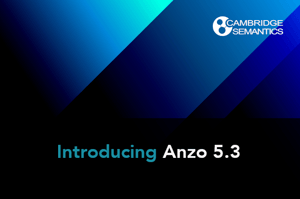We’re pleased to announce the release of Anzo® 5.3. This is a major release full of exciting capabilities to further enhance the leading knowledge graph platform solution, Anzo. Foremost, it’s now easier and faster than ever to create knowledge graphs with new codeless capabilities centered around discovering, analyzing, and connecting your enterprise data. In addition, the 5.3 release gives users an array of capabilities centered around increasing the speed and ease of data onboarding, as well as key enhancements for workflow management and migration. Here are a few highlights of the release. For full release notes, please visit the Cambridge Semantics Documentation Portal.
 Direct Data Loading (DDL) is the latest knowledge graph innovation from Cambridge Semantics. It enables users to create knowledge graphs directly from relational and semi-structured data sources, skipping the need to create intermediate copies of data in graph data formats (RDF). We have eager, happy customers already using Direct Data Loading to build knowledge graphs directly from diverse data sources like HTTP API, RDBMS, Parquet files, and JSON files. For these customers, it has sped-up data onboarding by 30-40%. For the Anzo 5.3 release, Direct Data Loading is in Preview mode and will be generally available in the months to come. This feature was designed to be flexible and meet a wide array of use cases via three interfaces:
Direct Data Loading (DDL) is the latest knowledge graph innovation from Cambridge Semantics. It enables users to create knowledge graphs directly from relational and semi-structured data sources, skipping the need to create intermediate copies of data in graph data formats (RDF). We have eager, happy customers already using Direct Data Loading to build knowledge graphs directly from diverse data sources like HTTP API, RDBMS, Parquet files, and JSON files. For these customers, it has sped-up data onboarding by 30-40%. For the Anzo 5.3 release, Direct Data Loading is in Preview mode and will be generally available in the months to come. This feature was designed to be flexible and meet a wide array of use cases via three interfaces:
- No-code: With the click of a button, generate load queries from RDBMS and CSV sources.
- Low-code: Utilize heuristics to generate data models and transformations dynamically from diverse data sources, with just a few lines of SPARQL.
- Developer: You’re in control. The user has full control over defining the data source, selecting and defining source schema, and mapping and transforming data from source to graph using SPARQL.
A popular request from customers was to simplify the migration of Anzo artifacts between development, staging, and production environments. The new Migration Packages empower administrators to create packages of Anzo artifacts through a user interface and to automate migration via a command-line interface. Packages are organized by artifact types (ontologies, datasets, graphmart, etc.) to make it easy to manage with Git. We’ve also added a powerful templating capability to Migration Packages. Templating enables administrators to replace configurations that are likely to change between environments. For example: source databases servers IPs, users access controls, and more.
Another common request was to make scheduling and operationalizing daily tasks easier. Well, we did just that. The Workflow Manager empowers developers to order Anzo operations and to trigger execution via external tools, like the popular Linux Cron or others. For example, you can define a workflow that will trigger data onboarding to run every two hours and refresh the knowledge graph.
Automating data onboarding is not a task to take lightly, it requires a fine-tuned process. File source incremental ingestion is a no-code capability that enables loading only new files that were created/modified since the last ingestion. This is powerful! Applications now have the capability to ingest new data in near real-time for analysis. This new incremental ingestion capability also complements the existing database source incremental ingestion. Meaning, Anzo now supports incremental ingestion from both databases and file sources.
A driving principle for Cambridge Semantics has been to make it easy for users to understand their knowledge graph. We’re introducing not one, but two new no-code features that push the envelope in helping users navigate and interpret their knowledge graphs with ease: Find Connections and Data Profiling.
Find Connections is a no-code feature that finds and surfaces relationships in the knowledge graph. The algorithm calculates the overlap between fields and/or values, discovering hidden relationships even if the field names (headers) are very different. For example, Anzo will identify the relationship between the product class and sales class using the id and items properties.
Users can configure various strategies and confidence intervals to adjust Anzo’s algorithm to analyze the instance data and produce suggested interconnections. Users have the final say whether to accept the connection or discard it. Since Find Connection is still in Preview, please reach out to your customer success representative if you are interested in giving it a try.
The Data Profiling capability enables users to perform no-code data quality control and data discovery through a set of metrics that are computed on the knowledge graph. This is a great feature to quickly see data samples, high-level statistics (average, minimum, maximum, etc.), common patterns (SSN: xxx-yy-zzzz), and much more.
For those not familiar with us, Cambridge Semantics Inc. is a modern data management and enterprise analytics software company. Our product Anzo is the most complete, scalable, and powerful knowledge graph platform available. Anzo transforms siloed data into knowledge graphs, revealing previously hidden insights, fueling pervasive analytics, and making previously unanswerable questions answerable. Our solutions enable organizations in Financial Services, Government, Healthcare, Life Sciences, Manufacturing, and Retail to accelerate data delivery and provide meaningful insights enterprise-wide at hyper-speed and scale.
For full release notes, please visit the Cambridge Semantics Documentation Portal.
